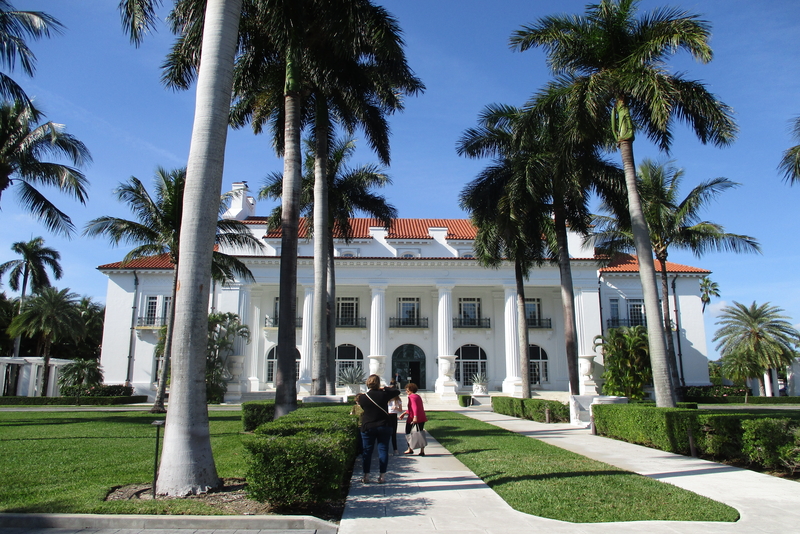Flagler Mansion, Miami, USA

Knowing that I love History ( my first Masters was in History) my doc son in Tennessee took me to see the Flagler Estate in West Palm Beach. It was a jaw dropping moment for both of us when we saw the building at first with its prime waterfront position.
When it was completed in 1902, the New York Herald proclaimed that Whitehall, Henry Flagler's Gilded Age estate in Palm Beach, was "more wonderful than any palace in Europe, grander and more magnificent than any other private dwelling in the world." Today, Whitehall is a National Historic Landmark and is open to the public as the Flagler Museum, featuring guided tours.
What never ceases to amaze me is the brilliant minds of these pioneers who made modern day America what it is. On my last visit I saw the Vanderbuilt mansion and there too the man’s genius built an empire which his family finally has lost. Future generations don’t have the foresight of the original founder, so common across the world. They faced hardship and came up the tough way. Their progeny are used to wealth and turn lazy and fritter away the billions they are left, sadly.
Henry Morrison Flagler was born on January 2, 1830 in Hopewell, New York, to Reverend and Mrs. Isaac Flagler. At the age of 14, after completing the eighth grade, Flagler moved to Bellevue, Ohio where he found work with his cousins in the grain store of L.G. Harkness and Company, at a salary of $5 per month plus room and board.
In 1852 Henry Flagler became a partner in the newly organized D. M. Harkness and Company with his half-brother, Dan Harkness. The following year, on November 9, he married Mary Harkness. They had three children, Jennie Louise, Carrie, Henry Harkness. Unfortunately, only Henry Harkness would survive to have children, one of which would later establish the Flagler Museum.
In 1862, Henry Flagler and his brother-in-law, Barney York, founded the Flagler and York Salt Company, a salt mining business in Saginaw, Michigan. When the Civil War ended however, salt, which had been in heavy use as preservative by the Union Army, was no longer in high demand and Flagler and York Salt Company collapsed. Heavily in debt, Flagler returned to Bellevue, Ohio - his initial investment of $50,000 and an additional $50,000 he had borrowed from his father-in-law and Dan Harkness were lost.
The next year Flagler re-entered the grain business as a commission merchant and paid back the money he had borrowed for the salt business. During this time, Flagler became acquainted with John D. Rockefeller, who worked as a commission agent. During the mid 1860s, Cleveland was quickly developing as the center of the oil refining industry in America and Rockefeller decided to leave the grain business to start his own oil refinery. In need of capital for his new venture, Rockefeller approached Henry Flagler, with whom he had business dealings for many years. Flagler secured $100,000 from a relative on the condition that he be made a partner owning 25% of the shares in the new company of Rockefeller, Andrews and Flagler.
On January 10, 1870, the Rockefeller, Andrews and Flagler partnership was organized as a joint-stock corporation named Standard Oil. In just two years Standard Oil became the leader in the American oil refining industry, producing 10,000 barrels per day. Five years later Standard Oil moved its headquarters to New York City, and the Flaglers moved to their new home to 509 Fifth Avenue in New York City.
In 1878, Flagler's wife, Mary, who had always struggled with health problems, became very ill. On the advice from Mary's physician, she and Flagler visited Jacksonville, Florida for the winter. Unfortunately, Mary did not recover. She died on May 18, 1881 at age 47, leaving Henry Flagler with a young son to raise alone. Two years after Mary's death, Flagler married Ida Alice Shourds. Soon after their wedding, the couple traveled to St. Augustine, Florida, which they found charming but lacking in adequate hotel facilities and transportation systems. Flagler believed that Florida had the potential to attract large numbers of tourists. Though Flagler remained on the Board of Directors of Standard Oil, he gave up his day-to-day involvement in the corporation in order to pursue his interests in Florida. He returned to St. Augustine in 1885 and began construction of the 540-room Hotel Ponce de Leon. Realizing the importance of a transportation system to support his hotel ventures, Flagler purchased the Jacksonville, St. Augustine & Halifax Railroad, the first railroad in what would eventually become the Florida East Coast Railway system.
The Hotel Ponce de Leon opened January 10, 1888 and was an instant success. Two years later, Flagler expanded his Florida holdings, building a railroad bridge across the St. Johns River to gain access to the southern half of the state. Flagler began building a hotel empire by purchasing the Hotel Ormond, just north of Daytona.
In 1894 Flagler built the Hotel Royal Poinciana on the shores of Lake Worth in Palm Beach and extended his railroad further south to West Palm Beach. The Hotel Royal Poinciana soon became the largest resort in the world. In 1896 Flagler built the Palm Beach Inn overlooking the Atlantic Ocean in Palm Beach.
Flagler's railroad, renamed the Florida East Coast Railway in 1895, reached Biscayne Bay by 1896. Flagler dredged a channel, built streets, instituted the first water and power systems, and financed the town's first newspaper, the Metropolis. When the town incorporated in 1896, its citizens wanted to honour the man responsible for its growth by naming it "Flagler." He declined the honor, persuading them instead to use an old Indian name for the river the settlement was built around, Miama or Miami. A year later, Flagler opened the exclusive Hotel Royal Palm in Miami.
Flagler lost his second wife, Ida Alice, to mental illness, which she suffered from for many years. Ida Alice finally had to be institutionalized in 1895. On August 24, 1901, Flagler married for the third time, to Mary Lily Kenan. Built as a wedding present to Mary Lily in 1902 and designed by architects John Carrère and Thomas Hastings, Whitehall became the Flagler's winter home. With more than 100,000 square feet and 75-plus rooms, Whitehall was described in 1902 by the New York Herald as, "... more wonderful than any palace in Europe, grander and more magnificent than any other private dwelling in the world."
A little more than a year later, Flagler fell down a flight of stairs at Whitehall. He never recovered from the fall, and died of his injuries on May 20, 1913, at 83 years of age. He was laid to rest in St. Augustine alongside his daughters, Jennie Louise and Carrie, and his first wife, Mary Harkness.
When Henry Flagler began his work in Florida, it was perhaps the poorest state in the Union. Today, thanks in large part to Henry Flagler, Florida is the third largest state in the Union with an economy larger than 90% of the world's nations. Indeed, no individual had a greater or more lasting impact on a state than Henry Flagler had on Florida.
Perfect for visitors looking for a dose of culture, Whitehall is the home of the Flagler Museum, a beautiful oasis that is worthy of a day trip. Built for his third wife as a wedding present, Henry Flagler constructed this over-the-top 55-room Beaux Arts style complex in 1902. A National Historic Landmark, visitors can stroll through the grounds of this Palm Beach attraction to take in a variety of historic European styles, and are welcome to browse the interior and see the building’s many original furnishings in addition to interesting exhibits, fabulous paintings,clocks and antique furniture.
Carrere and Hastings designed the exterior of Whitehall, the interior layout and completely controlled the design of the marble entrance hall and its grand double staircase. The façade of Whitehall is marked by massive marble columns and topped with a red barrel tiled roof. Built around the central courtyard, the house consists of two floors, an attic and a basement. Besides the grand public rooms on the first floor there are twelve guestrooms, house servants rooms on the west side of the second floor and guests servants rooms in the attic along the east side.
When it was completed in 1902, the New York Herald proclaimed that Whitehall, Henry Flagler's Gilded Age estate in Palm Beach, was "more wonderful than any palace in Europe, grander and more magnificent than any other private dwelling in the world." Today, Whitehall is a National Historic Landmark and is open to the public as the Flagler Museum, featuring guided tours.
What never ceases to amaze me is the brilliant minds of these pioneers who made modern day America what it is. On my last visit I saw the Vanderbuilt mansion and there too the man’s genius built an empire which his family finally has lost. Future generations don’t have the foresight of the original founder, so common across the world. They faced hardship and came up the tough way. Their progeny are used to wealth and turn lazy and fritter away the billions they are left, sadly.
Henry Morrison Flagler was born on January 2, 1830 in Hopewell, New York, to Reverend and Mrs. Isaac Flagler. At the age of 14, after completing the eighth grade, Flagler moved to Bellevue, Ohio where he found work with his cousins in the grain store of L.G. Harkness and Company, at a salary of $5 per month plus room and board.
In 1852 Henry Flagler became a partner in the newly organized D. M. Harkness and Company with his half-brother, Dan Harkness. The following year, on November 9, he married Mary Harkness. They had three children, Jennie Louise, Carrie, Henry Harkness. Unfortunately, only Henry Harkness would survive to have children, one of which would later establish the Flagler Museum.
In 1862, Henry Flagler and his brother-in-law, Barney York, founded the Flagler and York Salt Company, a salt mining business in Saginaw, Michigan. When the Civil War ended however, salt, which had been in heavy use as preservative by the Union Army, was no longer in high demand and Flagler and York Salt Company collapsed. Heavily in debt, Flagler returned to Bellevue, Ohio - his initial investment of $50,000 and an additional $50,000 he had borrowed from his father-in-law and Dan Harkness were lost.
The next year Flagler re-entered the grain business as a commission merchant and paid back the money he had borrowed for the salt business. During this time, Flagler became acquainted with John D. Rockefeller, who worked as a commission agent. During the mid 1860s, Cleveland was quickly developing as the center of the oil refining industry in America and Rockefeller decided to leave the grain business to start his own oil refinery. In need of capital for his new venture, Rockefeller approached Henry Flagler, with whom he had business dealings for many years. Flagler secured $100,000 from a relative on the condition that he be made a partner owning 25% of the shares in the new company of Rockefeller, Andrews and Flagler.
On January 10, 1870, the Rockefeller, Andrews and Flagler partnership was organized as a joint-stock corporation named Standard Oil. In just two years Standard Oil became the leader in the American oil refining industry, producing 10,000 barrels per day. Five years later Standard Oil moved its headquarters to New York City, and the Flaglers moved to their new home to 509 Fifth Avenue in New York City.
In 1878, Flagler's wife, Mary, who had always struggled with health problems, became very ill. On the advice from Mary's physician, she and Flagler visited Jacksonville, Florida for the winter. Unfortunately, Mary did not recover. She died on May 18, 1881 at age 47, leaving Henry Flagler with a young son to raise alone. Two years after Mary's death, Flagler married Ida Alice Shourds. Soon after their wedding, the couple traveled to St. Augustine, Florida, which they found charming but lacking in adequate hotel facilities and transportation systems. Flagler believed that Florida had the potential to attract large numbers of tourists. Though Flagler remained on the Board of Directors of Standard Oil, he gave up his day-to-day involvement in the corporation in order to pursue his interests in Florida. He returned to St. Augustine in 1885 and began construction of the 540-room Hotel Ponce de Leon. Realizing the importance of a transportation system to support his hotel ventures, Flagler purchased the Jacksonville, St. Augustine & Halifax Railroad, the first railroad in what would eventually become the Florida East Coast Railway system.
The Hotel Ponce de Leon opened January 10, 1888 and was an instant success. Two years later, Flagler expanded his Florida holdings, building a railroad bridge across the St. Johns River to gain access to the southern half of the state. Flagler began building a hotel empire by purchasing the Hotel Ormond, just north of Daytona.
In 1894 Flagler built the Hotel Royal Poinciana on the shores of Lake Worth in Palm Beach and extended his railroad further south to West Palm Beach. The Hotel Royal Poinciana soon became the largest resort in the world. In 1896 Flagler built the Palm Beach Inn overlooking the Atlantic Ocean in Palm Beach.
Flagler's railroad, renamed the Florida East Coast Railway in 1895, reached Biscayne Bay by 1896. Flagler dredged a channel, built streets, instituted the first water and power systems, and financed the town's first newspaper, the Metropolis. When the town incorporated in 1896, its citizens wanted to honour the man responsible for its growth by naming it "Flagler." He declined the honor, persuading them instead to use an old Indian name for the river the settlement was built around, Miama or Miami. A year later, Flagler opened the exclusive Hotel Royal Palm in Miami.
Flagler lost his second wife, Ida Alice, to mental illness, which she suffered from for many years. Ida Alice finally had to be institutionalized in 1895. On August 24, 1901, Flagler married for the third time, to Mary Lily Kenan. Built as a wedding present to Mary Lily in 1902 and designed by architects John Carrère and Thomas Hastings, Whitehall became the Flagler's winter home. With more than 100,000 square feet and 75-plus rooms, Whitehall was described in 1902 by the New York Herald as, "... more wonderful than any palace in Europe, grander and more magnificent than any other private dwelling in the world."
A little more than a year later, Flagler fell down a flight of stairs at Whitehall. He never recovered from the fall, and died of his injuries on May 20, 1913, at 83 years of age. He was laid to rest in St. Augustine alongside his daughters, Jennie Louise and Carrie, and his first wife, Mary Harkness.
When Henry Flagler began his work in Florida, it was perhaps the poorest state in the Union. Today, thanks in large part to Henry Flagler, Florida is the third largest state in the Union with an economy larger than 90% of the world's nations. Indeed, no individual had a greater or more lasting impact on a state than Henry Flagler had on Florida.
Perfect for visitors looking for a dose of culture, Whitehall is the home of the Flagler Museum, a beautiful oasis that is worthy of a day trip. Built for his third wife as a wedding present, Henry Flagler constructed this over-the-top 55-room Beaux Arts style complex in 1902. A National Historic Landmark, visitors can stroll through the grounds of this Palm Beach attraction to take in a variety of historic European styles, and are welcome to browse the interior and see the building’s many original furnishings in addition to interesting exhibits, fabulous paintings,clocks and antique furniture.
Carrere and Hastings designed the exterior of Whitehall, the interior layout and completely controlled the design of the marble entrance hall and its grand double staircase. The façade of Whitehall is marked by massive marble columns and topped with a red barrel tiled roof. Built around the central courtyard, the house consists of two floors, an attic and a basement. Besides the grand public rooms on the first floor there are twelve guestrooms, house servants rooms on the west side of the second floor and guests servants rooms in the attic along the east side.

Related Articles
Editor's Picks Articles
Top Ten Articles
Previous Features
Site Map
Content copyright © 2023 by Marianne de Nazareth. All rights reserved.
This content was written by Marianne de Nazareth. If you wish to use this content in any manner, you need written permission. Contact Marianne de Nazareth for details.





 -resizeimage.jpg.jpg)

